Effect of Oxygen Plasma Treatment on Wheat Emergence and Yield in the Field
Abstract
1. Introduction
2. Results and Discussion
2.1. Emergence of Plants in the Field
2.2. Yield of Wheat Seeds after Harvest
2.3. Correlation between Plant Emergence and Yield
3. Materials and Methods
3.1. Seed Material
3.2. Plasma Reactor
3.3. Plasma Treatment
3.4. Eco Coating Application
3.5. Experimental Design
3.6. Emergence of Plants in the Field
3.7. Yield of Wheat Seeds after Harvest
3.8. Statistical Analysis
4. Conclusions
Author Contributions
Funding
Institutional Review Board Statement
Informed Consent Statement
Data Availability Statement
Acknowledgments
Conflicts of Interest
References
- Fischer, R.A. Definitions and determination of crop yield, yield gaps, and of rates of change. Field Crops Res. 2015, 182, 9–18. [Google Scholar] [CrossRef]
- Starič, P.; Vogel-Mikuš, K.; Mozetič, M.; Junkar, I. Effects of nonthermal plasma on morphology, genetics and physiology of seeds: A review. Plants 2020, 9, 1736. [Google Scholar] [CrossRef] [PubMed]
- Holc, M.; Vesel, A.; Zaplotnik, R.; Paul, D.; Primc, G.; Mozetic, M.; Gselman, P.; Recek, N. Surface modifications of wheat cultivar bologna upon treatment with non-equilibrium gaseous plasma. Plants 2022, 11, 1552. [Google Scholar] [CrossRef] [PubMed]
- Filatova, I.; Lyushkevich, V.; Goncharik, S.; Zhukovsky, A.; Krupenko, N.; Kalatskaja, J. The effect of low-pressure plasma treatment of seeds on the plant resistance to pathogens and crop yields. J. Phys. D Appl. Phys. 2020, 53, 244001. [Google Scholar] [CrossRef]
- Hasan, M.; Sohan, M.S.R.; Sajib, S.A.; Hossain, M.F.; Miah, M.; Maruf, M.M.H.; Khalid-Bin-Ferdaus, K.M.; Kabir, A.H.; Talukder, M.R.; Rashid, M.M.; et al. The effect of low-pressure dielectric barrier discharge (lpdbd) plasma in boosting germination, growth, and nutritional properties in wheat. Plasma Chem. Plasma Process. 2022, 42, 339–362. [Google Scholar] [CrossRef]
- Hui, Y.T.; Wang, D.C.; You, Y.; Shao, C.Y.; Zhong, C.S.; Wang, H.D. Effect of low temperature plasma treatment on biological characteristics and yield components of wheat seeds (Triticum aestivum L.). Plasma Chem. Plasma Process. 2020, 40, 1555–1570. [Google Scholar] [CrossRef]
- Jiang, J.; He, X.; Li, L.; Li, J.; Shao, H.; Xu, Q.; Ye, R.; Dong, Y. Effect of cold plasma treatment on seed germination and growth of wheat. Plasma Sci. Technol. 2014, 16, 54–58. [Google Scholar] [CrossRef]
- Roy, N.C.; Hasan, M.M.; Talukder, M.R.; Hossain, M.D.; Chowdhury, A.N. Prospective applications of low frequency glow discharge plasmas on enhanced germination, growth and yield of wheat. Plasma Chem. Plasma Process. 2017, 38, 13–28. [Google Scholar] [CrossRef]
- Roy, N.C.; Hasan, M.M.; Kabir, A.H.; Reza, M.A.; Talukder, M.R.; Chowdhury, A.N. Atmospheric pressure gliding arc discharge plasma treatments for improving germination, growth and yield of wheat. Plasma Sci. Technol. 2018, 20, 115501. [Google Scholar] [CrossRef]
- Saberi, M.; Modarres-Sanavy, S.A.M.; Zare, R.; Ghomi, H. Amelioration of photosynthesis and quality of wheat under non-thermal radio frequency plasma treatment. Sci. Rep. 2018, 8, 11655. [Google Scholar] [CrossRef] [PubMed]
- Saberi, M.; Modarres-Sanavy, S.A.M.; Zare, R.; Ghomi, H. Improvement of photosynthesis and photosynthetic productivity of winter wheat by cold plasma treatment under haze condition. J. Agric. Sci. Technol. 2019, 21, 1889–1904. [Google Scholar]
- Sohan, M.S.R.; Hasan, M.; Hossain, M.F.; Sajib, S.A.; Miah, M.M.; Iqbal, M.A.; Karmakar, S.; Alam, M.J.; Khalid-Bin-Ferdaus, K.M.; Kabir, A.H.; et al. Improvement of seed germination rate, agronomic traits, enzymatic activity and nutritional composition of bread wheat (triticum aestivum) using low-frequency glow discharge plasma. Plasma Chem. Plasma Process. 2021, 41, 923–944. [Google Scholar] [CrossRef]
- Zhang, B.; Li, R.H.; Yan, J.C. Study on activation and improvement of crop seeds by the application of plasma treating seeds equipment. Arch. Biochem. Biophys. 2018, 655, 37–42. [Google Scholar] [CrossRef] [PubMed]
- Marinković, D.; Borcean, I. Effect of cold electron plasma and extremely low frequency electron-magnetic field on wheat yield. Res. J. Agric. Sci. 2009, 41, 96–101. [Google Scholar]
- Hampton, J.G. The relationship between field emergence, laboratory germination, and vigour testing of new zealand seed wheat lines. N. Z. J. Exp. Agric. 1981, 9, 191–197. [Google Scholar] [CrossRef]
- Klein, R.N. How to Select the Winter Wheat Varieties Best for Your Operation. 2007. Available online: https://cropwatch.unl.edu/how-select-winter-wheat-varieties-best-your-operation (accessed on 2 August 2022).
- Starič, P.; Mlakar, S.G.; Junkar, I. Response of two different wheat varieties to glow and afterglow oxygen plasma. Plants 2021, 10, 1728. [Google Scholar] [CrossRef] [PubMed]
- Šerá, B.; Gajdová, I.; Černák, M.; Gavril, B.; Hnatiuc, E.; Kováčik, D.; Kříha, V.; Slama, J.; Šerý, M.; Špatenka, P. How various plasma sources may affect seed germination and growth. In Proceedings of the 13th International Conference on Optimization of Electrical and Electronic Equipment (OPTIM), Brasov, Romania, 24–26 May 2012; Clotea, L.R., Gerigan, C., Cernat, M., Eds.; IEEE: Piscataway, NJ, USA, 2012; pp. 1365–1370. [Google Scholar]
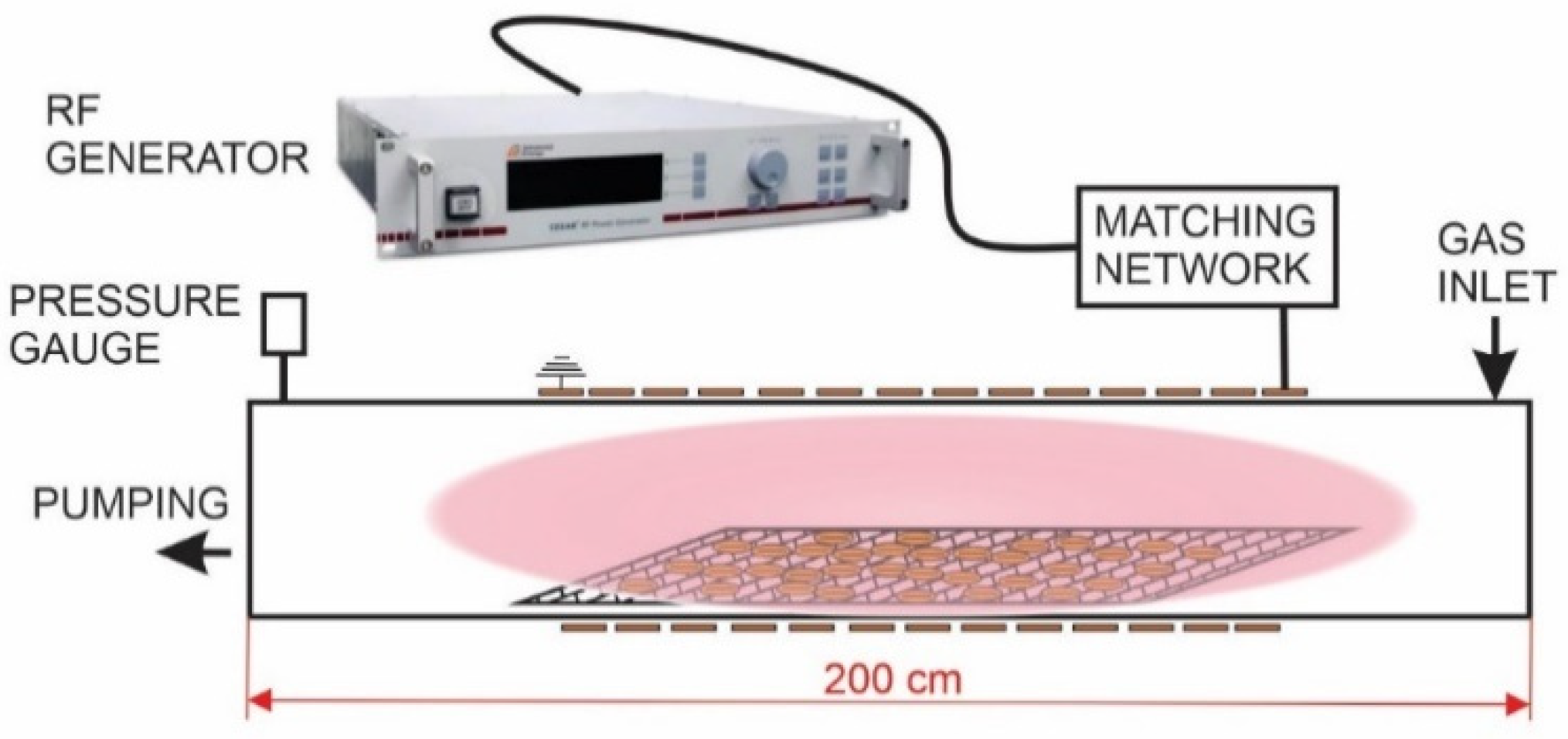
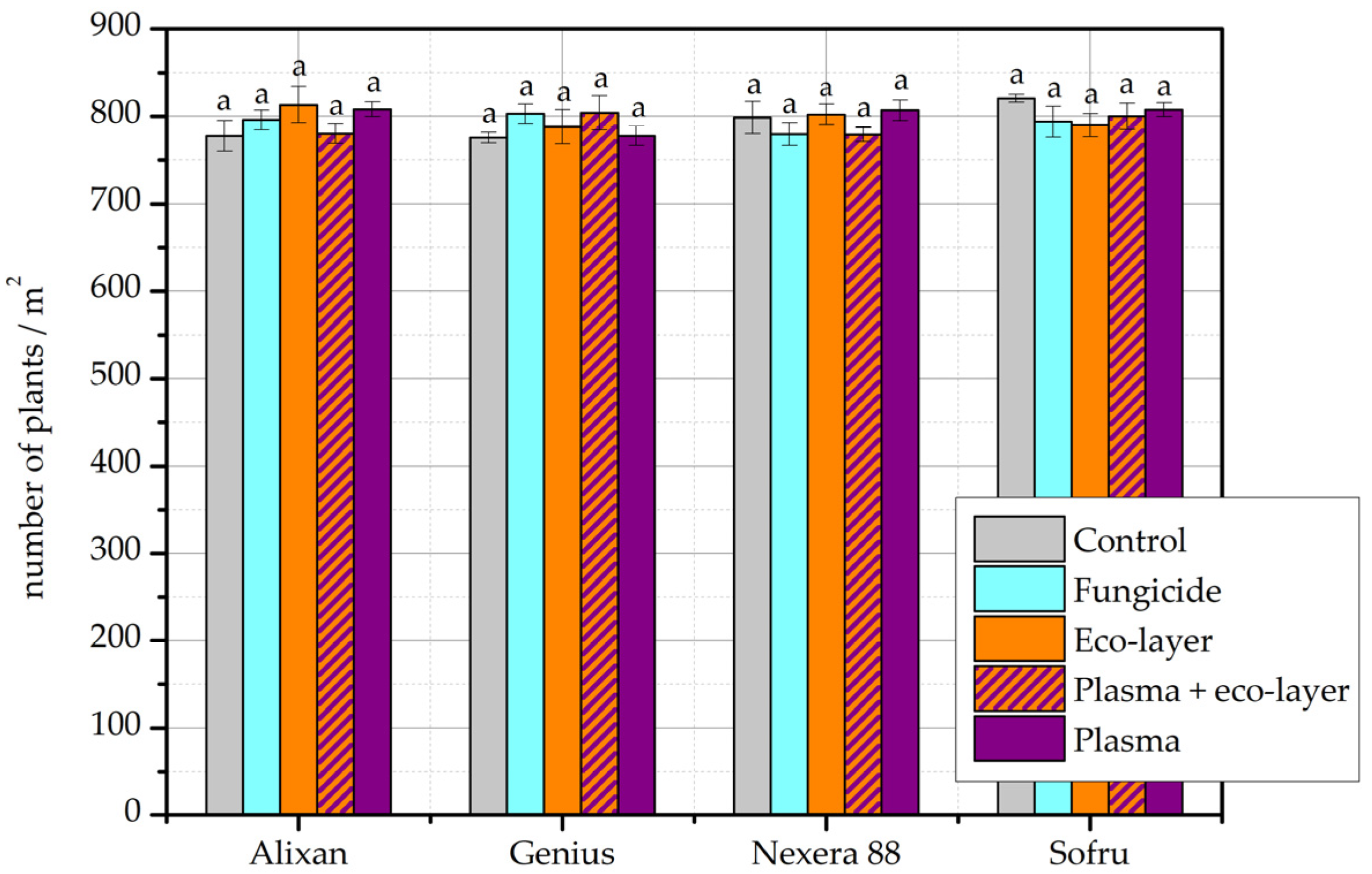
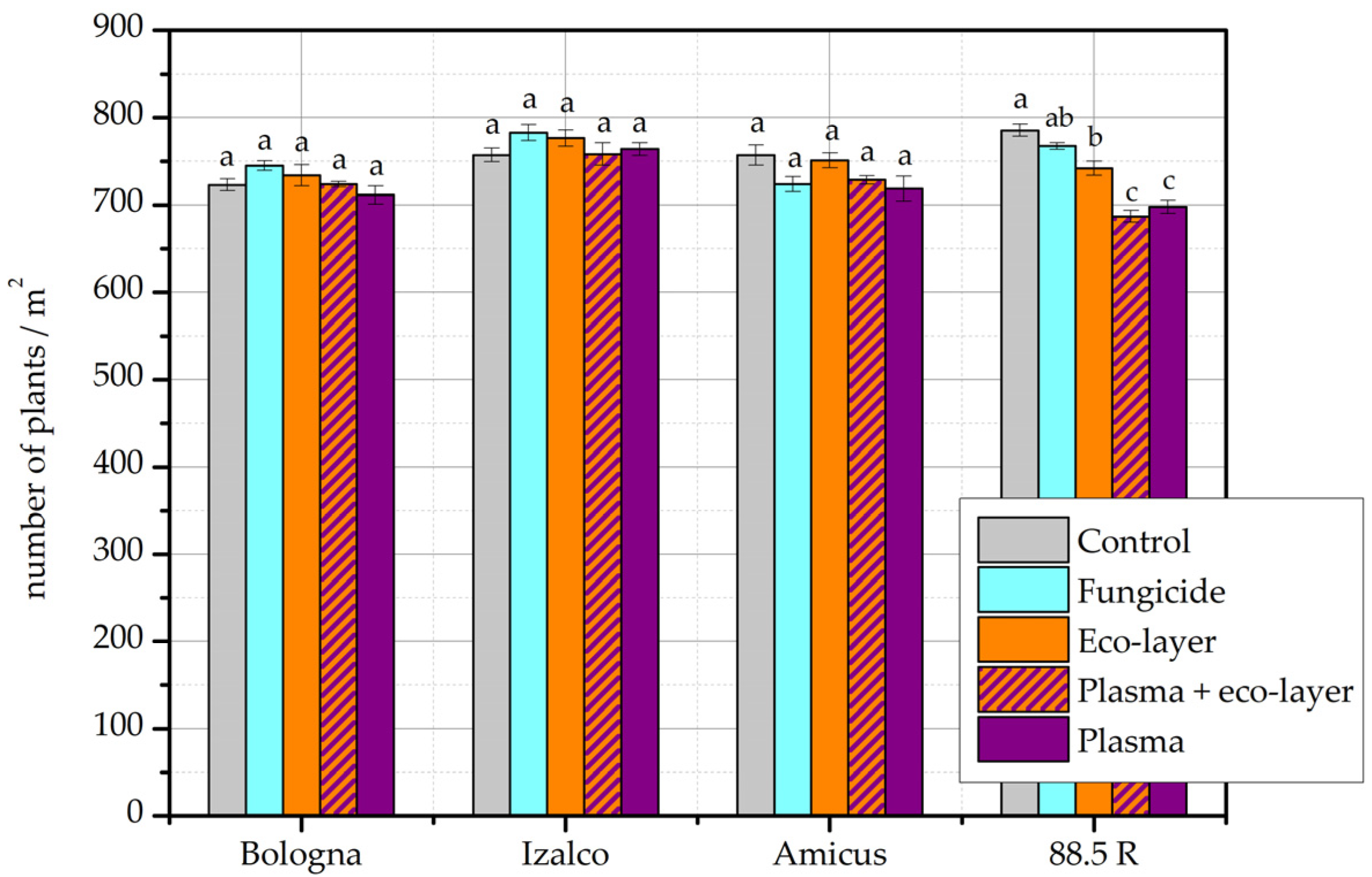

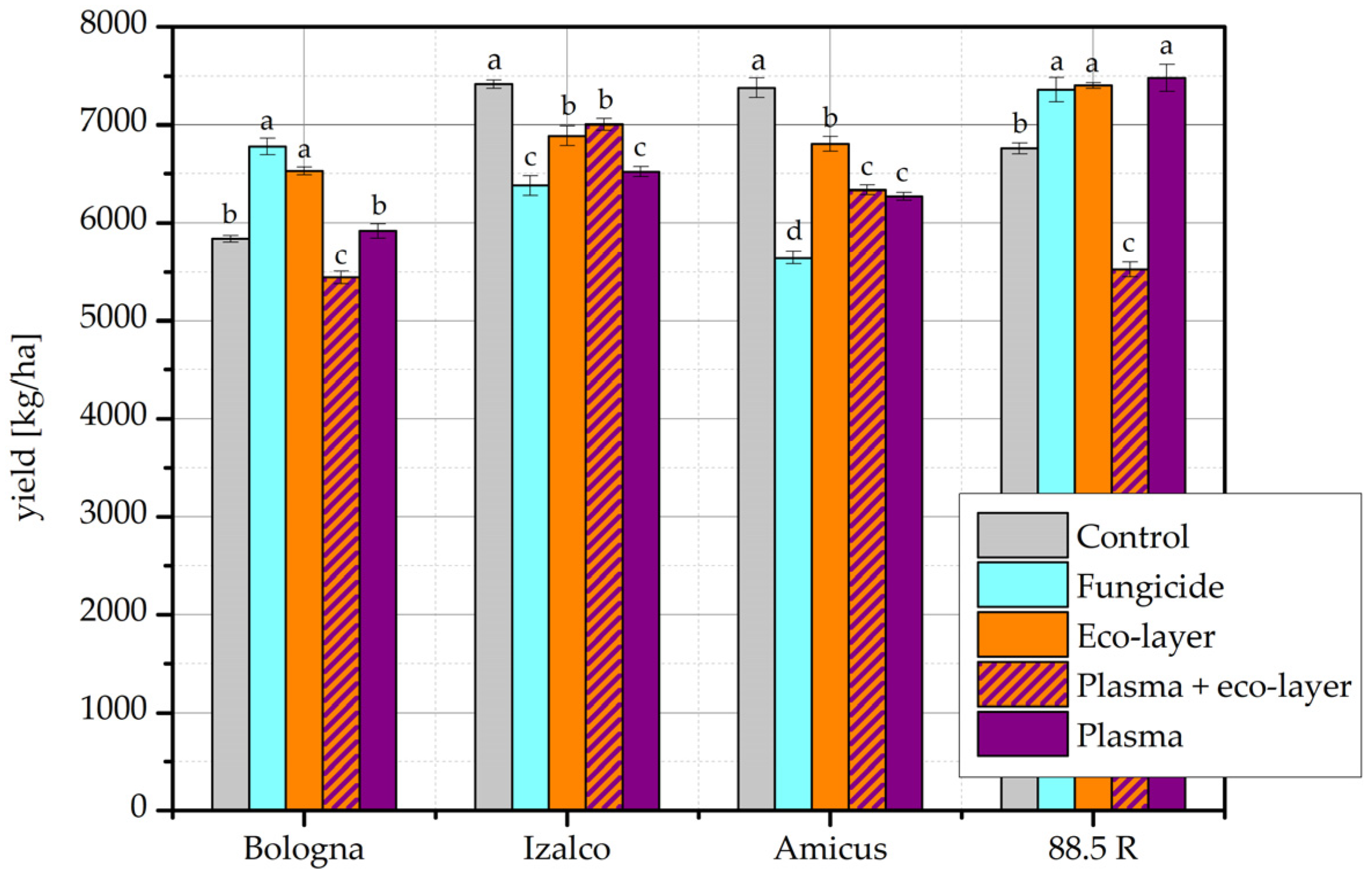
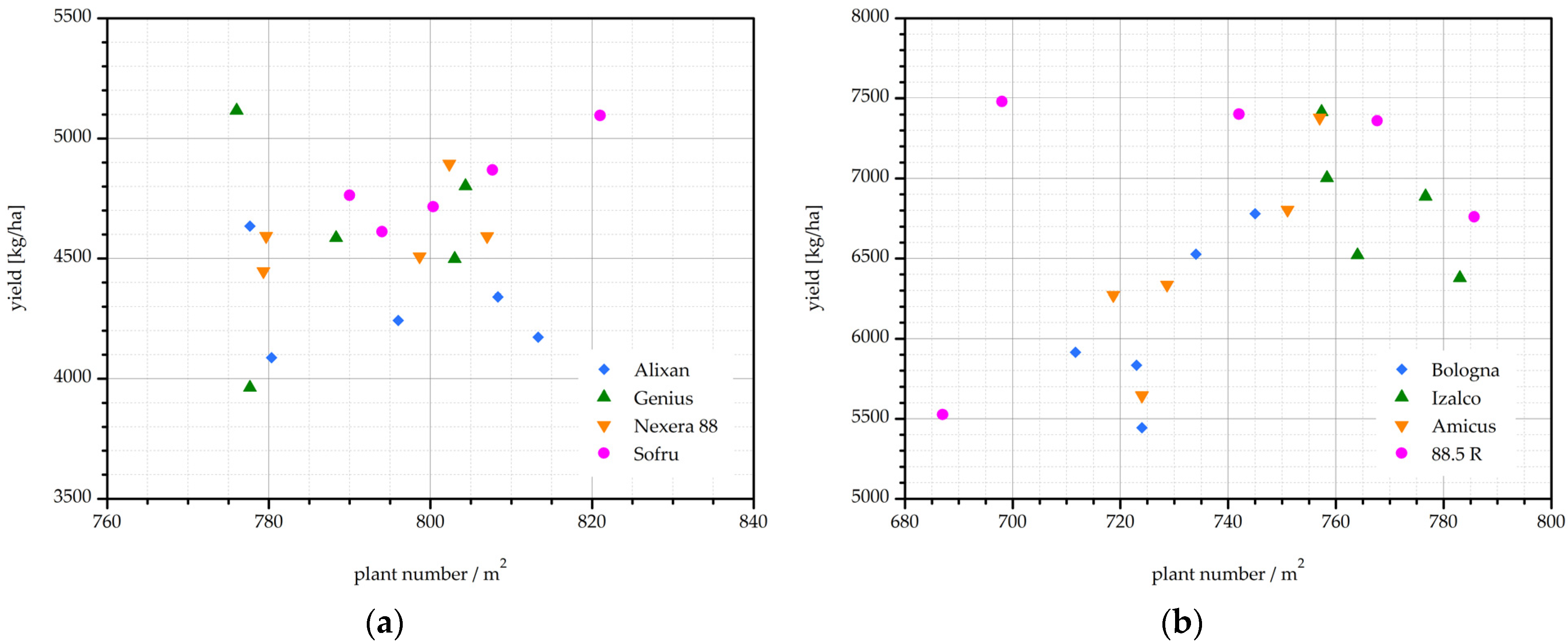
| Author | Year | Plasma | Gas | p [Pa] | Yield | ↑ Yield [%] | Other Effects | Plot | Plot per Condition | Stress |
|---|---|---|---|---|---|---|---|---|---|---|
| Filatova [4] | 2020 | CC RF | air | 200 | ↑ yield, ↑ 1000-grain weight | 2.3 | unch./↓ GR, ↑ S/R, ↓ % fungal inf., ↓ disease severity (field) | field | 25 m2 | fungi |
| Hasan [5] | 2022 | DBD | air | 1333 | ↑ yield (g/m2), ↑ 1000-grain weight, ↑ grains/spike | 27.06 | etching, cracks (SEM), ↑ GR, ↑ S/R, ↑ growth, ↑ chlorophyll, biochem. changes, enzyme activity | field | 4 m2 | n/a |
| Hui [6] | 2020 | CC RF | air/He | 130–160 | ↑ yield (theoretical, actual) (kg/plot), unch, 1000-grain weight, unch. grains/spike, unch. spikes/plot | 8.12 | ↑ GR (1st gen.), ↑ S, unch. R, ↑ growth | field | 660 m2 | n/a |
| Jiang [7] | 2014 | CC RF | He | 150 | ↑ yield (t/ha) | 5.9 | ↑ GR, ↑ R, ↑ growth, ↑ chlorophyll | field | 6 ha | n/a |
| Roy [8] | 2017 | glow | air, air/O2 | 1333 | ↑ yield (t/ha), ↑ length of spike, ↑ spikelets/spike, ↑ grains/spike, ↑ 1000-grain weight | ~20 | altered surface (SEM), ↑ WU, ↑ GR, ↑ plant length, ↑ growth, ↑ chlorophyll | field | n/a | n/a |
| Roy [9] | 2018 | gliding arc | air/O2/H2O | atm | ↑ yield (g/m2), ↑ length of spike, ↑ spikelets/spike, ↑ grains/spike, ↑ 1000-grain weight | ~20 | ↑ WU, ↑ GR, ↑/unch. plant length, ↑ growth, ↑ chlorophyll | field | 5 m2 | n/a |
| Saberi [10] | 2018 | CC RF | air | 10 | ↑ yield (grain, biological) (g/m2), ↑ 1000-grain weight | 31.62 | ↑ photosynthesis, biochem. changes | field | 20 rows, 6 m | n/a |
| Saberi [11] | 2019 | CC RF | air | low | ↑ yield (grain, spike) (g/plant) | 58 | ↑ photosynthesis, biochem. changes | greenhouse | 3 pots, 3 seedlings /pot | haze |
| Sohan [12] | 2021 | glow | air, Ar/O2 | 1333 | ↑ 1000-grain weight | n/a | etching (SEM), ↑ GR, ↑ S/R, ↑ growth, ↑ chlorophyll, biochem. changes, enzyme activity | field | 4 m2 | n/a |
| Zhang [13] | 2018 | CC RF | air, air/He | 30–200 | ↑ 1000-grain weight, ↑ grains/spike | n/a | ↑ GR, ↑ S/R, ↑ growth parameters, enzyme activity | field | n/a | drought |
Publisher’s Note: MDPI stays neutral with regard to jurisdictional claims in published maps and institutional affiliations. |
© 2022 by the authors. Licensee MDPI, Basel, Switzerland. This article is an open access article distributed under the terms and conditions of the Creative Commons Attribution (CC BY) license (https://creativecommons.org/licenses/by/4.0/).
Share and Cite
Holc, M.; Mozetič, M.; Zaplotnik, R.; Vesel, A.; Gselman, P.; Recek, N. Effect of Oxygen Plasma Treatment on Wheat Emergence and Yield in the Field. Plants 2022, 11, 2489. https://doi.org/10.3390/plants11192489
Holc M, Mozetič M, Zaplotnik R, Vesel A, Gselman P, Recek N. Effect of Oxygen Plasma Treatment on Wheat Emergence and Yield in the Field. Plants. 2022; 11(19):2489. https://doi.org/10.3390/plants11192489
Chicago/Turabian StyleHolc, Matej, Miran Mozetič, Rok Zaplotnik, Alenka Vesel, Peter Gselman, and Nina Recek. 2022. "Effect of Oxygen Plasma Treatment on Wheat Emergence and Yield in the Field" Plants 11, no. 19: 2489. https://doi.org/10.3390/plants11192489
APA StyleHolc, M., Mozetič, M., Zaplotnik, R., Vesel, A., Gselman, P., & Recek, N. (2022). Effect of Oxygen Plasma Treatment on Wheat Emergence and Yield in the Field. Plants, 11(19), 2489. https://doi.org/10.3390/plants11192489








